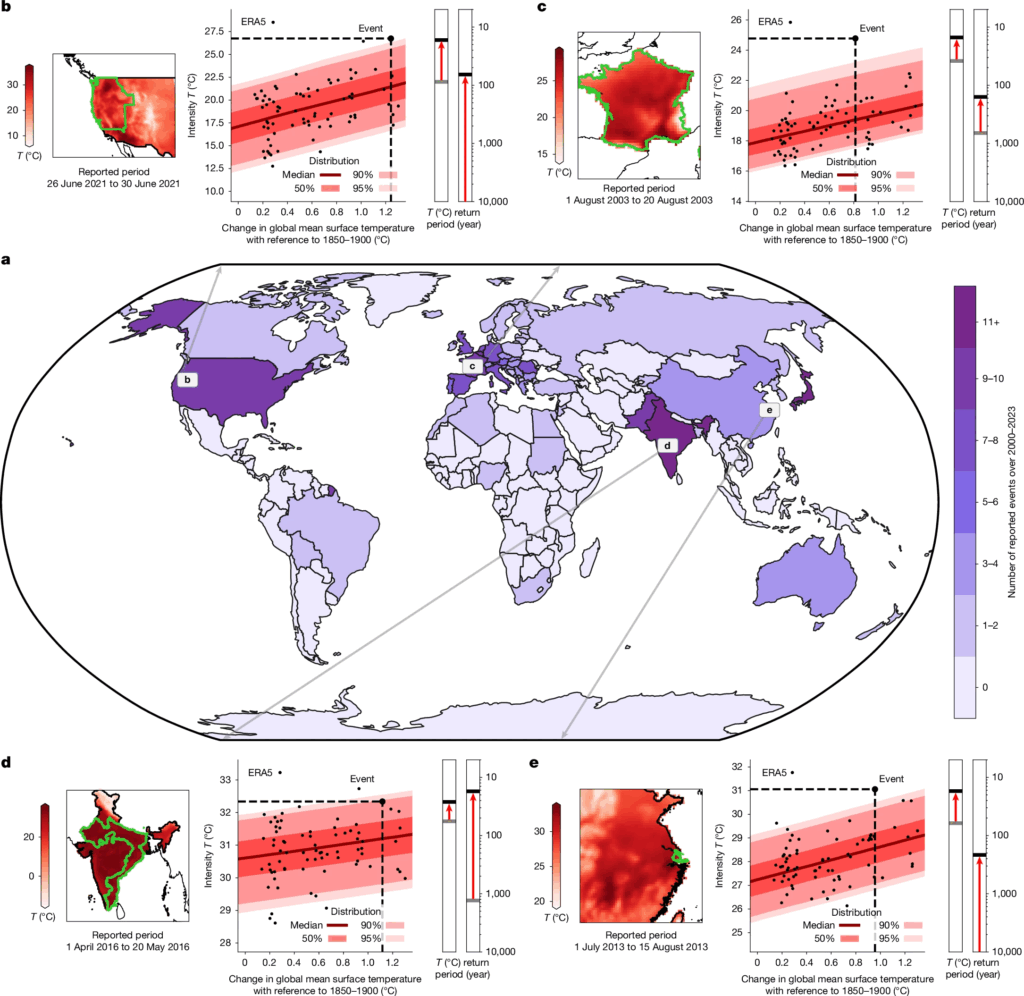PAPER: SYSTEMATIC ATTRIBUTION OF HEATWAVES TO THE EMISSIONS OF CARBON MAJORS
The paper is led by Yann Quilcaille (ETH Zürich) and 12 other co-authors acknowledging support from 6 EU projects and grants including XAIDA.
Reference: Quilcaille, Y., Gudmundsson, L., Schumacher, D.L. et al. Systematic attribution of heatwaves to the emissions of carbon majors. Nature 645, 392–398 (2025). https://doi.org/10.1038/s41586-025-09450-9
« (…) global warming made heatwaves 20 times more likely between 2000 and 2009, and as much as 200 times more likely between 2010 and 2019, compared with the period between 1850 and 1900.
(…) Researchers analysed the emissions that were facilitated by the 180 largest producers of fossil fuels and cement – referred to in the study as “carbon majors”. The emissions from these carbon majors account for 60 percent of humanity’s total cumulative CO2 emissions from 1850 to 2023, with the rest of the CO2 emissions largely attributable to land use activities. The researchers then calculated the contribution of each carbon major to the change in global average temperature.
(…) About half of the change in global mean surface temperature in 2023 can be explained by the emissions of carbon majors,” says Quilcaille. Fourteen of the 180 entities stand out: they have made the same contribution to climate change as the remaining 166 organisations combined.
According to the study, the five largest producers of fossil fuels among state-owned entities or investor-owned companies are from the former Soviet Union, followed by the People’s Republic of China (due to coal production), and the oil and/or gas exporters: Saudi Aramco, Gazprom, and ExxonMobil.
“While the 14 largest carbon majors have contributed the most to the occurrence of heatwaves, the contributions of smaller players also play a significant role,” says Quilcaille. Even the CO2 emissions of the smallest of the 180 carbon giants, the Russian coal producer, Elgaugol, are still enough to cause 16 heat waves according to the calculations. The individual contributions of each one of the 14 largest players is enough to cause over 50 heatwaves that would have been almost impossible without climate change. »
Extract from the ETH Zürich Press Realease
We can provide for the first time a systematic attribution of recent heatwaves to the emissions of carbon majors. Essential new Nature article coordinated by Yann Quilcaille at ETH Zürich, with numerous contributors: Lukas Gudmundsson, Dominik Schumacher, Thomas Gasser, Richard Heede, Corina Heri, Quentin Lejeune, Shruti N., Philippe Naveau, Wim Thiery, Carl-Friedrich Schleussner & Sonia Seneviratne.
Key results:
- We investigated the attribution of heatwaves in the time frame 2000-2023
- With human-induced global warming, the median of the heatwaves became 20 times more likely in 2000-2009 and 200 times more likely in 2010-2019 compared to pre-industrial climate (1850-1900)
- About 55 heatwaves in this time frame were virtually impossible without human-induced climate change
- A clear contribution of the carbon majors to the increased probability of heatwaves can be identified, even on an individual level, and even for the smallest of carbon majors
- Depending on the carbon major, their individual contribution is
high enough to enable the occurrence of 16–53 heatwaves that would have been virtually impossible in a pre-industrial climate - Legal implications could be important, especially in the context of the recent advisory opinion provided by the Cour internationale de Justice (CIJ)

From the paper | Figure 1 – For every reported heatwave, the contribution of climate change to the event is assessed using statistical models and multiple lines of evidence.
Abstract:
Extreme event attribution assesses how climate change affected climate extremes, but typically focuses on single events1,2,3,4. Furthermore, these attributions rarely quantify the extent to which anthropogenic actors have contributed to these events5,6. Here we show that climate change made 213 historical heatwaves reported over 2000–2023 more likely and more intense, to which each of the 180 carbon majors (fossil fuel and cement producers) substantially contributed. This work relies on the expansion of a well-established event-based framework1. Owing to global warming since 1850–1900, the median of the heatwaves during 2000–2009 became about 20 times more likely, and about 200 times more likely during 2010–2019. Overall, one-quarter of these events were virtually impossible without climate change. The emissions of the carbon majors contribute to half the increase in heatwave intensity since 1850–1900. Depending on the carbon major, their individual contribution is high enough to enable the occurrence of 16–53 heatwaves that would have been virtually impossible in a preindustrial climate. We, therefore, establish that the influence of climate change on heatwaves has increased, and that all carbon majors, even the smaller ones, contributed substantially to the occurrence of heatwaves. Our results contribute to filling the evidentiary gap to establish accountability of historical climate extremes7,8.
